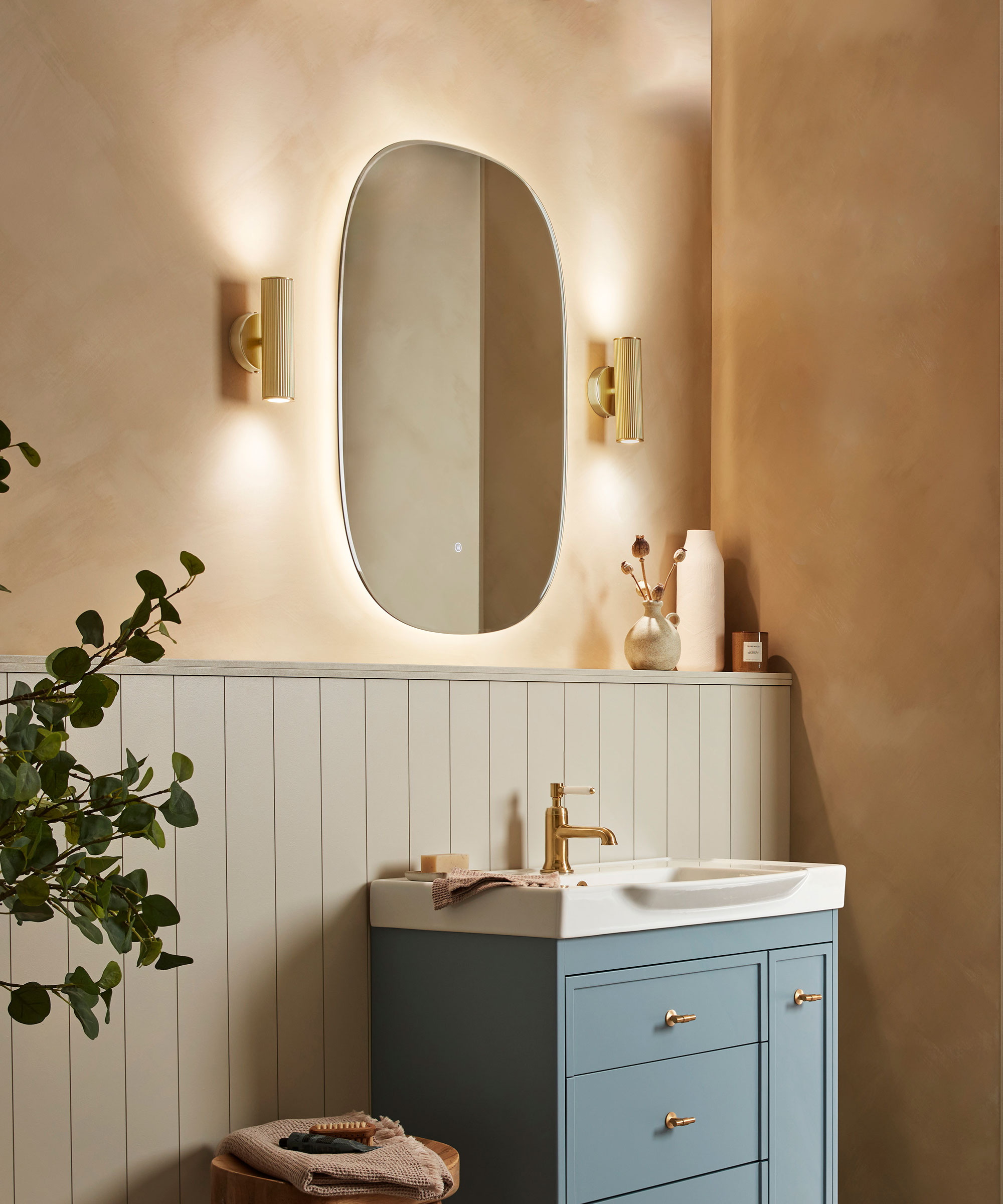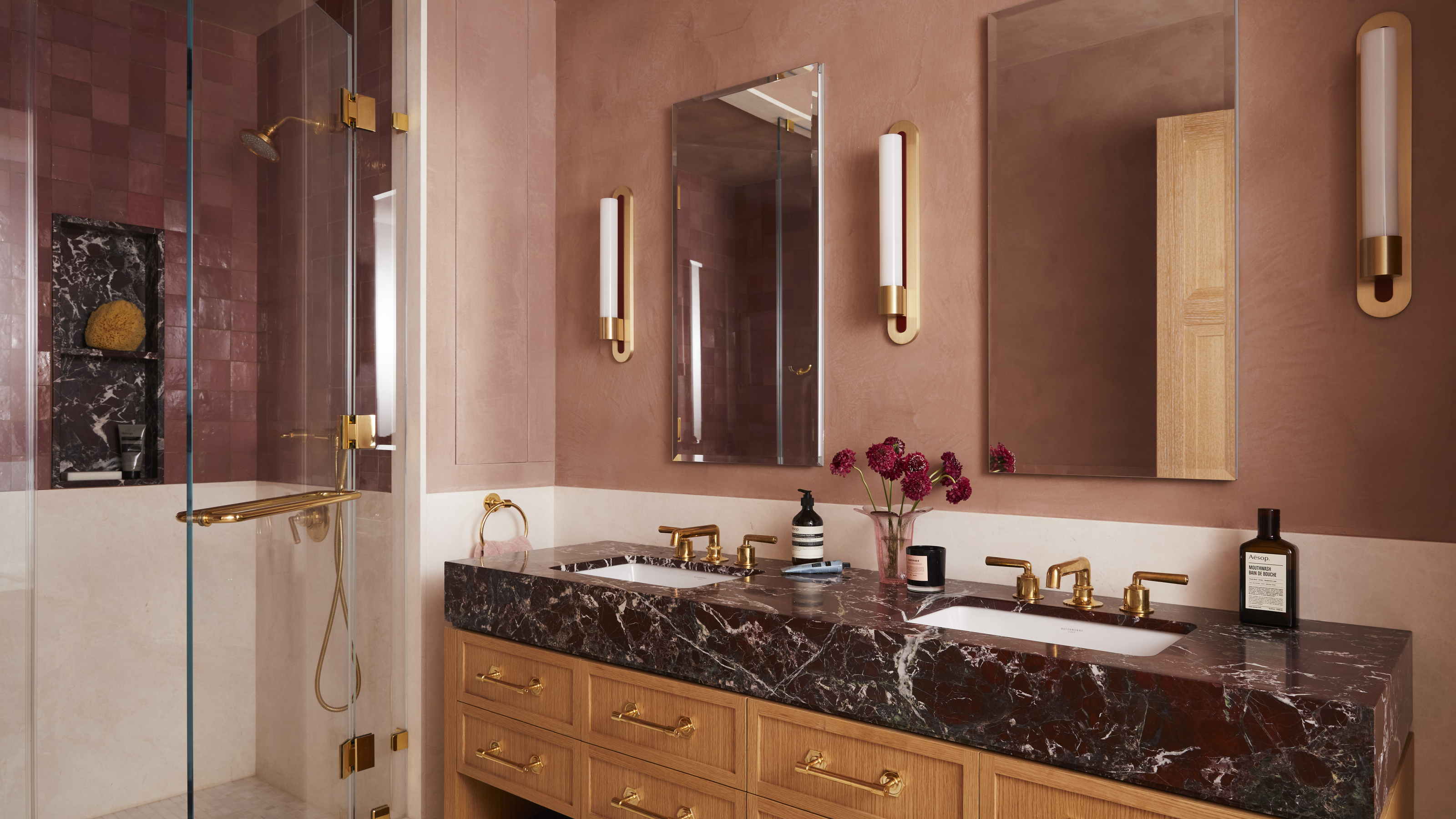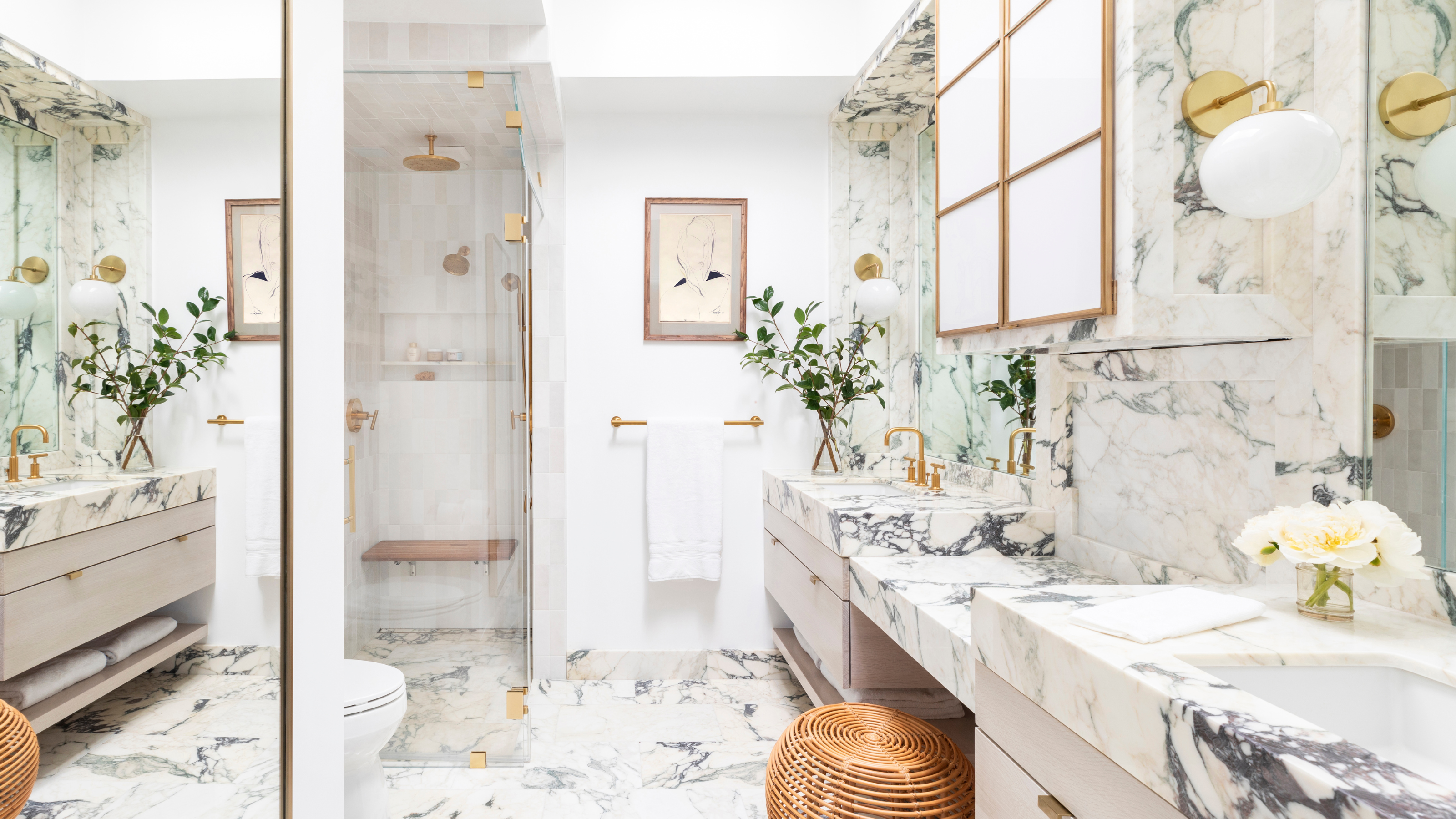How to Plan Bathroom Lighting That Can Switch Between Bright and Busy, and Spa-Like in Seconds
Our expert-led guide to bathroom lighting gives you everything you need for a perfectly-lit space


It seems strange how often planning your bathroom lighting gets left as a bit of an afterthought given the huge role it plays in the both the look and feel of a space.
Getting the lighting spot on in this room can be tricky and there are definitely some bathroom lighting mistakes to avoid at all costs.
"If the bathroom is too bright, the atmosphere isn’t relaxing and can feel too sterile," says Pam Durkin, president at James Martin Vanities. "If too dim, you might not have enough dedicated illumination."
With this in mind, we're here to explain exactly how to plan your bathroom lighting for a space that feels both restful and restorative, all while making the user experience as smooth as possible.
How do you make a bathroom lighting layout plan?
It can be hard to know where to start with a bathroom lighting scheme but thinking in terms of layers really can make the process easier, as will thinking about who will be using the space.
"Start with the big fixture for main lighting," suggests Dara Greaney, CEO and founder of LED Light Expert. "This is often in ceiling lights but can be a light bar over the mirror or even a flood lamp. Second, consider task lighting (vanity lights or a make-up mirror), then accent lights such as sconces or table lamps."
One of the golden rules for bathrooms is to make sure you really consider how you plan on using the space. Is this a family bathroom where children will be bathed? Or perhaps you are aiming for a chic and stylish space to be used by grown ups only.
"The first thing you want to do when you plan out a bathroom lighting scheme is to think about how you use that space," agrees George Crew, owner at Chicago Construction Crew. "Is it a quick morning routine, or is it a spa-like retreat at the end of the day you want?"
Once you've established that, here's what you need to do to plan your bathroom lighting.
1. Use a minimum of three lighting types

Just because the bathroom is, primarily, a practical space, doesn't mean it won't benefit just as much from taking a layered approach to your lighting as any other room in the house.
"To make the bathroom comfortable to use, it's better to have three types of lighting rather than just one light on the ceiling," explains Evelina Juzėnaitė, principal interior designer at Planner 5D.
She goes on to explain how to use these three lighting types in layers, including for your vanity lighting ideas.
"General/main (also known as background or ambient) lighting comes from the lights on the ceiling, which can be ceiling-mounted or recessed. Task lighting is lighting that will help you perform certain functions, such as lighting at the mirror and sink, or dressing table," continues Evelina. "Accent lighting is additional lighting for coziness, for example an illuminated shelf with an LED strip, or the bottom of the bathtub."
A good bathroom scheme will have all three, and they'll be planned in a way that feels cohesive. For example, pair functional dimmable recessed lights (from Amazon) and waterproof LED lighting strips (also from Amazon) with more a more aesthetic feature light, to create a space that can flick between 'work' and 'rest' in seconds.

Price: $39.94
This elegant three-light over-mirror fitting is perfect for providing just the right kind of illumination for a spot of preening. The three bulbs come included and offer a 4000K color temperature. Easy installation can also be expected.
2. Give plenty of thought to your task lighting

It is normal to begin with general, background lighting when planning a lighting scheme and, while this is important in the bathroom, it really will pay to focus much of your attention on getting the task lighting in this room right, whether that is through your bathroom wall lighting ideas or mirror lighting.
"Thoughtfully placed task lighting where you need it allows for precision during make-up application and grooming," explains Michelle Woolley Sauter, owner at One Coast Design.
And the positioning of your task lighting is particularly important. "Bathrooms need excellent task lighting, especially around the mirror, for activities like shaving or applying make-up," adds Carolyn Cerminara, founder and principal designer at Cerminara Design.

Price: $228
A beautiful wall light for the bathroom, this pretty fitting is damp rated. The alabaster shade works perfectly alongside the brushed brass details.
3. Add in a little interest with hidden light sources

Your accent lighting is what really finishes a space off and is your chance to draw attention to certain features in the room that you love, add depth and create different bathroom design moods.
"Accent lighting is often overlooked but can elevate the space," says Carolyn Cerminara. "LED strips around a make-up station or under cabinets create a soft, luxurious glow."
Pam Durkin, president at James Martin Vanities says accent lighting is how you add interest and drama to your bathroom design. "Examples include recessed LED strip lighting to highlight certain features like wall niches and built-in shelves, or under-cabinet, toe-kick lighting that is useful as a subtle night light."
4. Aim for a neutral color temperature for an accurate reflection

If you are wondering what is the most flattering light for a bathroom, you need to know about color temperature. Color temperature is measured in Kelvins (K) and there are three options: warm, neutral and cool. Each comes with different uses and benefits.
"CRI measures color temperature and determines how a light source renders colors compared to the complete spectrum source of the same color in natural light," explains Pam Durkin. "A low CRI light makes applying make-up very difficult, as it will make colors appear unnatural. The ideal CRI rating around a bathroom mirror is around 90.
"A neutral white light (3000K-4000K) is recommended for accurate color rendering and a refreshing, natural appearance," continues Pam. "You’ll want to pay close attention to the bulbs selected to avoid overly warm or cool lights to prevent unnatural tones."
That said, it can be a good idea to introduce a couple of lights with a slightly warmer color temperature. "I always recommend warm lighting of around 2700K because it’s flattering and avoids the harshness of cool blue light," says Carolyn Cerminara.
"Bulbs with a color temperature ranging from 2700K to 3000K will provide you with the nice, warm, inviting glow of a bulb," further adds George Crew. "A cool white from about 4000K can be used if you need something brighter for task focused areas."
5. Use dimmable lighting for flexibility

The ability to be able to adjust the brightness levels of your lighting at the press of a button is such a benefit in the bathroom, allowing you to switch tasks and activities seamlessly. It is also one of the best ways to make a lighting scheme feel cozy.
"Dimmable background light is popular in bathroom design," says Pam Durkin. "This will help to achieve a bright, energetic space in the mornings, and a soft, warm ambience for winding down in the evenings."
Along with dimmable lighting, there are also smart lighting systems that can be used to make the experience of using your bathroom the best it can be.
"Think about circadian lighting systems, which adjust the color temperature throughout the day to align with natural light cycles," suggests Sergey Nikolin, president at Product Air Heating & Cooling LLC. "This can enhance mood and energy levels, especially in windowless bathrooms.
"Plan for adaptive lighting zones — one switch could control soft ambient lighting, while another focuses on task-specific brightness," he adds.
6. Don't forget to light up your showering area

One area that tends to get forgotten about when it comes to lighting a bathroom is shower lighting ideas — yet this is one space that really needs some form of illumination.
"Don't forget that it is necessary to illuminate not only the center of the room and the mirror and sink, but also shower cabins," says Evalina Juzėnaitė. "They are usually installed in one of the corners of the room and are often less illuminated, which can affect your comfort and safety too."
"If you have a large bathroom, it is important to incorporate lighting in the shower area," agrees Pam Durkin. "Most often these are recessed overhead lights with wet-rated trims."
You should also take the time to consider the trend for shower lamps — they are a great way to cozy up a showering space.

Price: $39.99, Was: $69.99
This cordless lamp is totally waterproof and features touch operation which also allows you to dim it. Perfect for adding a cozy glow to your showering routine.
7. Choose lighting with safety in mind

Not all types of lighting are suitable for use in the bathroom, given the high levels of moisture present in the air in this room.
"Pay attention to the luminaire's humidity rating, because not all luminaires can be installed in humid areas," explains Evalina Juzėnaitė. "This way the luminaires will last longer and you will increase safety."
Lights should be clearly labeled with their IP rating. IP stands for 'Ingress Protection' and indicates how much moisture a fitting can be exposed to.
"Choose IP67 or higher to protect against immersion in water," continues Evelina. This would apply to inside shower enclosures, for example.
A rating of IP44 indicates a light is suitable for most areas outside direct water exposure but within reach of splashes, while an IP20+ rating is recommended for general use in damp areas.
"Fiber optic lighting for showers or bathtubs creates a luxurious, starry effect and avoids electrical safety risks," adds Sergey Nikolin.
8. Maximise any natural light the space enjoys

It isn't just artificial lighting that matters in the bathroom — the benefits of natural light in this space are huge too. "If your bathroom has a window, capitalize on that during the day," says George Crew. "Mirrors strategically placed can amplify this light, giving the impression of space and openness."
"If natural light is an option, it is an ideal light source to incorporate," agrees Pam Durkin. "In addition to the natural sunlight, you also get the added bonus of ventilation from having a window in the bathroom."
While windows come with lots of benefits, you do need to think through how your bathroom window treatment ideas will deal with the matter of privacy.
"To ensure privacy while still allowing light in, use frosted or textured glass, or add adjustable blinds to alter the amount of light and privacy throughout the day," suggests Pam Durkin.
Alternatively, a window film such as this 3D Reeded Frosted Decorative Window Decal from Wayfair would work well at letting light in and keeping prying eyes out.
FAQs
Where should lights be placed in the bathroom?
Your lighting's layout is really important in the bathroom. You want it to be practical, yet also flattering. Try to avoid overhead lighting in the bathroom as your only source.
"To avoid harsh shadows, I recommend vertical fixtures or sconces mounted on either side of the mirror," says Carolyn Cerminara. "This set-up ensures even lighting without the unflattering overhead shadows that can occur with poorly planned lighting."
Pam Durkin adds that sconces should mount on either side of the mirror and "be 66 inches above the floor," while "recessed lights should be centered in the room, then 4-6 feet apart."
"To avoid harsh shadows, it is important to be thoughtful when positioning lights above the vanity area," continues Pam. "For example, directly over the sink is an acceptable area to cast light directly downward, but never place a light directly over, or behind, the area where a person would stand in front of the vanity. Fixtures mounted above the vanity mirror should be approximately 80 inches above the floor."
How many lights should be in a bathroom?
Different types of bathroom require different amounts of light. There is no set number of fixtures you must aim for in the bathroom, it all depends on its size and how much natural light it receives. What is important, though, is that you aim for three 'types' of light: general (ambient or background), task and accent.
Once you have your lighting design in place, make sure you know all the tricks to make a bathroom layout work harder to ensure you are getting the most from your space.
Be The First To Know
The Livingetc newsletters are your inside source for what’s shaping interiors now - and what’s next. Discover trend forecasts, smart style ideas, and curated shopping inspiration that brings design to life. Subscribe today and stay ahead of the curve.

Natasha Brinsmead is a freelance homes and interiors journalist with over 20 years experience in the field. As former Associate Editor of Homebuilding & Renovating magazine, Natasha has researched and written about everything from how to design a new kitchen from scratch to knocking down walls safely, from how to lay flooring to how to insulate an old house. She has carried out a number of renovation projects of her own on a DIY basis and is currently on the lookout for her next project.
-
 I Tried Cozy Earth’s Bamboo Viscose Comforter — Is It Really Worth the Spend?
I Tried Cozy Earth’s Bamboo Viscose Comforter — Is It Really Worth the Spend?I spent two weeks back in my childhood bedroom — armed with a new comforter and high expectations — to find out
-
 Is Good Taste Hereditary? This Mother-Daughter Duo (and Their Recent Homewares Collaboration) Suggests So
Is Good Taste Hereditary? This Mother-Daughter Duo (and Their Recent Homewares Collaboration) Suggests SoLouise and Sophia Roe talk shop, sentiment, and the serendipity of turning a shared eye into a cult-favorite collection
-
 5 Bathroom Paint Mistakes to Avoid for a More Durable, Longer-Lasting Wall Color
5 Bathroom Paint Mistakes to Avoid for a More Durable, Longer-Lasting Wall ColorPainting a bathroom requires extra care and attention if you want a perfect finish that promises to last
-
 10 Small Bathroom Storage Ideas That Will Cull Clutter and Keep Even Tiny Spaces Feeling Calm
10 Small Bathroom Storage Ideas That Will Cull Clutter and Keep Even Tiny Spaces Feeling CalmUnlock the storage potential hidden in your small bathroom and squeeze stashing space from every corner
-
 5 Colors You Should Never Paint Your Bathroom — The Boring, Overstimulating, and Dating Shades These Designers Avoid
5 Colors You Should Never Paint Your Bathroom — The Boring, Overstimulating, and Dating Shades These Designers AvoidWe're here to save you from the trap of a bad-taste bathroom. Listen to the experts, and stay away from these shades. You've been warned!
-
 5 Bathroom Layouts That Look Dated in 2025 — Plus the Alternatives Designers Use Instead for a More Contemporary Space
5 Bathroom Layouts That Look Dated in 2025 — Plus the Alternatives Designers Use Instead for a More Contemporary SpaceFor a bathroom that feels in line with the times, avoid these layouts and be more intentional with the placement and positioning of your features and fixtures
-
 How to Make a Bathroom Look More Expensive — 5 Simple Upgrades That Will Elevate Your Space Instantly
How to Make a Bathroom Look More Expensive — 5 Simple Upgrades That Will Elevate Your Space InstantlyIf you're on a mission to create an elevated, luxe-feel bathroom on a budget, our experts are here to help
-
 Orchids in a Bathroom? This Plant Stylist Has a Clever Trick for Bringing This Beautiful Bloom Into the Space
Orchids in a Bathroom? This Plant Stylist Has a Clever Trick for Bringing This Beautiful Bloom Into the SpaceIf you're looking for inspiration to create a wellness-inspired bathroom, this clever DIY should be on your mood board. Spoiler alert: it features orchids.
-
 5 Problems With Heated Towel Rails People Never Talk About — And Whether They're Worth It in a Bathroom
5 Problems With Heated Towel Rails People Never Talk About — And Whether They're Worth It in a BathroomA toasty towel at the end of your shower is like wrapping yourself in a warm hug, but heated towel rails can have a host of hidden problems that aren't so comforting
-
 5 Bathroom Flooring Mistakes That Will Ruin Your Scheme's Good Looks and Make It a Nightmare to Use
5 Bathroom Flooring Mistakes That Will Ruin Your Scheme's Good Looks and Make It a Nightmare to UseYour floor tiling can transform your bathroom, but not always for the best. These are all the slip-ups experts want you to avoid